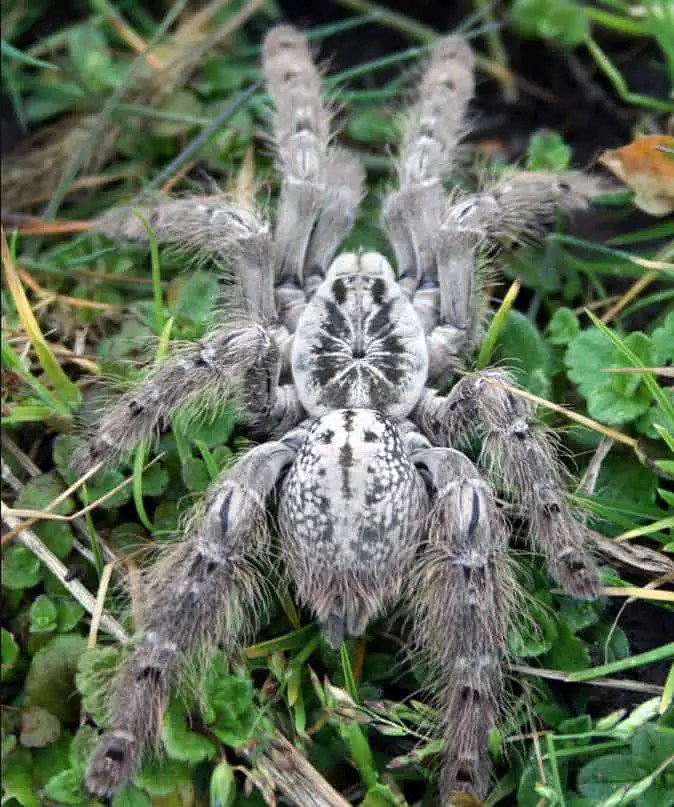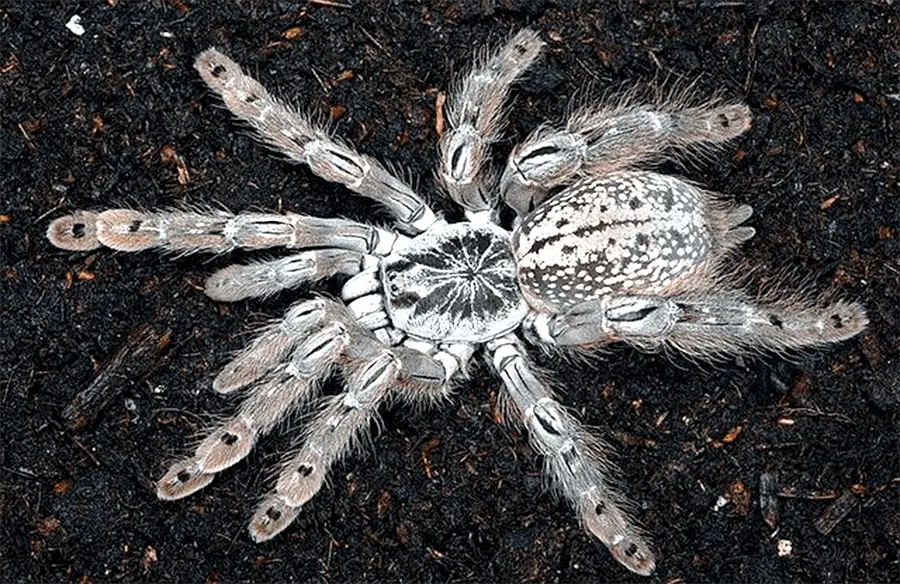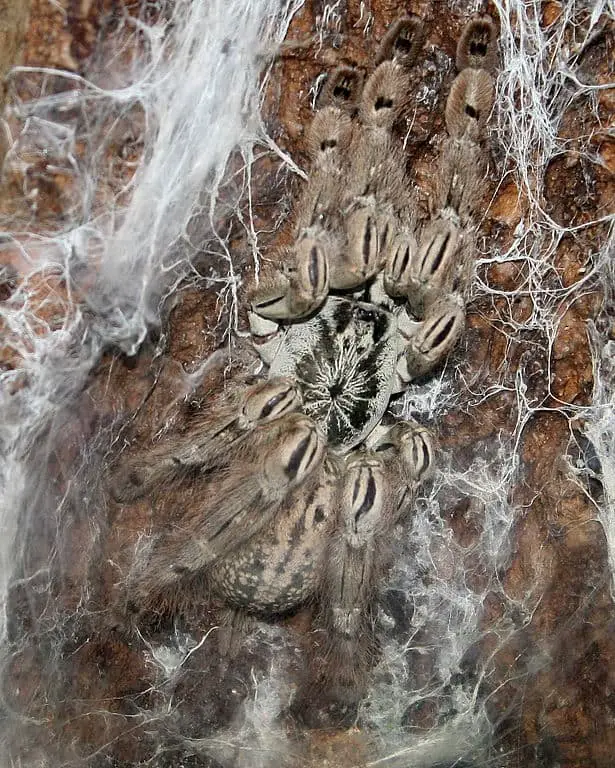The Ornamental Baboon tarantula (Heteroscodra maculata), also known as the Togo Starburst tarantula, is an Old World arboreal species that is popular among hobbyists. This spider is famous for its stunning looks, bad temper, and strong venom.
If you’re thinking about getting an OBT, there are definitely a few things that you need to know about them before you get one. For that reason, we’ve compiled all the info you need about the Ornamental Baboon Tarantula in this guide.

Ornamental Baboon Tarantula Care Sheet
| Species Name | Heteroscodra maculata |
| Family Name | Theraphosidae |
| Common Name | Ornamental Baboon Tarantula, Togo Starburst Tarantula |
| Category | Old World |
| Type | Arboreal |
| Native Location | West Africa |
| Body length | 2.3 inches (6 cm) |
| Leg Span | 5.1 inches (13 cm) |
| Growth Speed | Fast |
| Urticating Hairs | No |
| Social | Solitary |
| Diet | Crickets, roaches, mealworms. Also small birds in the wild. |
| Temperature | 81 to 86 degrees Fahrenheit |
| Humidity | 60 to 70% |
| Lifespan | Female: 12 to 15 years / Male: 3 to 4 years |
| Experience required | Intermediate |
| Minimum tank size | Three gallons, at least 12″ tall |
Ornamental Baboon Tarantula overview

The Heteroscodra maculata is known in the hobby under a few different names. The most common ones are Togo Starburst Tarantula, Togo Starburst Baboon Tarantula, and Ornamental Baboon Tarantula.
Out of all these names, she’s most commonly called Ornamental Baboon Tarantula for her incredible color pattern and location on trees. Since this is the name most commonly used for this species, that’s what we’ll refer to her as in the article.
This spider is mainly found in Togo and Ghana, but she’s also seen in Benin, Nigeria, Cameroon, and Congo.
She’s an arboreal spider, which means that she lives in the trees. As such, she needs a vertical surface to be comfortable. The Ornamental Baboon is a swift mover with potent venom, allowing her to catch birds by surprise, but she’ll also easily eat insects, which make up the majority of her food intake.
Appearance
The Ornamental Baboon Tarantula has incredible white, brown, and black patterns all over her body. She’s not the most colorful or flashy spider, but that’s on purpose because her patterns and colors work as camouflage over the trees.
These spiders grow fast and reach their full size of around 5 inches in about 3 years.
She has strong legs with a thick brush of hairs that make them seem bulkier than they are. Because their legs are so thick, many people confuse them with tarantulas in the Harpactirinae subfamily, which are baboon spiders.
However, the Ornamental Baboon Tarantula is actually not a real baboon spider because she is in the Heteroscodra family. It is just due to their appearance that people mistake them for baboon spiders and why they got their name.
Both males and females of this species share the same colors and patterns, but the males are much smaller than the females. It’s easy to identify the sex of a specimen by looking at its size.
Price
The Ornamental Baboon isn’t an expensive spider for two reasons. First, there are plenty of breeders that breed them, and second, they’re not all that popular in the hobby.
As a result, Juveniles can cost as little as $25. Sub-adult males cost around $69 while females cost $125, more or less. Female adults rise in price, going from $130 to $220.
The reason why males are usually cheaper is that they have a much shorter lifespan. Slings and juveniles are cheaper because it’s more difficult to raise them.
Behavior and Temperament

The Ornamental Baboon Tarantula is a defensive spider that should be raised with care. Her first instinct against stimuli will be to flee, but it doesn’t take much to push one to a threat posture.
They don’t bite out of nowhere, but they are indeed capable of biting if they feel that they need to defend themselves. They have powerful fangs and potent venom so being bitten is definitely not something you want to experience.
As an Old World species, she doesn’t have urticating hairs, but she’s still a threat with her fast movements and strong venom. As arboreal spiders, they’ll spend most of their time in the trees, but spiderlings are known to burrow.
Their potent venom and bad temper mean that they’re not a suitable spider for beginners. In addition, even for more experienced hobbyists, it’s not recommended to handle them.
Caring for an Ornamental Baboon Tarantula
Caring for tarantulas is luckily not very difficult or time-intensive. They’re among the most low-maintenance pets in the world. Giving them a good enclosure with optimal temperature & humidity, good substrate, and good food goes a long way in making them happy.
Temperature and Humidity
In the wild, The Ornamental Baboon Tarantula lives in a tropical climate. Temperatures in her natural habitat range from 81°F to 86°F. In captivity, ideal temperatures for this species are between 76°F and 83°F and humidity from 60% to 70%.
It’s also important to ensure that there is enough ventilation in the enclosure to prevent mold and bacterial growth.
Substrate
The Ornamental Baboon Tarantula spends most of its time in high places, so the substrate isn’t as important for them as for terrestrial species.
Spiderlings are the only ones known to burrow, so at this stage, you should place at least three inches of substrate in their vials.
As they move out of the vials and into their larger enclosure, you should provide them with two inches of substrate all the way to adulthood. As for the soil composition, a mixture of vermiculite, peat moss, coconut fiber, and dirt is good enough for these arboreal spiders.
Tank
An adult Ornamental Baboon Tarantula will spend most of its time in a tree. Tanks should be much taller than long and wide to allow them room to move up and down.
However, as stated in the substrate segment, spiderlings and juveniles enjoy spending more time on the ground. You should still give them a small twig to let them climb if they feel like it.
An ideal tank should be at least three gallons and twelve inches tall. You should add a tree bark of at least ten inches tall; this will work as a climbing structure and a hiding place.
The Ornamental Baboon Tarantula enjoys creating a large web around her hide, so placing moss and leaves in the tank helps her build it. With their aggressive behavior and great climbing abilities, it’s best to have a security lid in the tank.
Social
While some tarantulas are capable of communal living, the Ornamental Baboon Tarantula is definitely not a social species.
In the wild, they meet others of their species solely to mate, and even that often ends in cannibalism. As a result, you should always house these spiders separately and never put more than one in an enclosure.
Watering
The Ornamental Baboon Tarantula lives in a climate where it rains and is humid for around eight months every year. They’re used to moist floors, so even if they don’t spend much time over their substrates, some owners choose to moisten the substrate every other month.
To drink, they need a water dish. Make sure that the water in it is refilled and refreshed frequently to avoid the buildup of bacteria and mold. Since they’re an arboreal species, it’s better for them if you superglue the dish to the bark because that makes it easier for them to drink.
Diet & Feeding
The Ornamental Baboon Tarantula should be fed a diet that consists primarily of a variety of different insects.
They have a healthy appetite, so they eat plenty of prey despite their relatively small size.
Spiderlings should be fed a baby cricket or a flightless fruit fly twice a week. Juveniles should be fed one or two medium crickets every four to seven days. Adults should eat about seven large crickets or two B. dubia roaches every seven to ten days. Some owners choose to gut load the insects to ensure that the spider gets all the required nutrients.
Pay attention to their abdomens and shift their diet accordingly if it’s getting too plump or skinny. Reduce portions and frequency if you’re overfeeding your tarantula, and increase them if you see their abdomens getting smaller.
Ornamental Baboon Tarantula Facts
- Reginald Innes Pocock was the first to describe this species in 1899.
- The name “Baboon” comes from her strong back legs that make her similar to other baboon spiders. However, they’re not part of the Harpactirinae subfamily.
- The Heteroscodra maculata was thought to be part of the Harpactirinae subfamily, but she was moved to the Aviculariinae subfamily in 2017.
- The Ornamental Baboon Tarantula shares her habitat with the Feather leg Baboon (Stromatopelma calceatum), another spider that receives the name of baboon even though she’s not part of the Harpactirinae subfamily either.
- The Ornamental Baboon Tarantula will attach her egg sac to a wall inside her vertical burrow.
Final words
Due to its defensive nature and potent venom, the Ornamental Baboon Tarantula isn’t a great fit for beginners. Beginners are better off starting with an easier-to-handle species first, such as the Mexican Pink, Mexican Red Rump, or Greenbottle Blue tarantula.
However, if you’re an experienced hobbyist, this spider can be a great addition to your collection. She honors her name by being an incredibly beautiful show spider with her beautiful patterns and is sure to steal the show due to the fact that she’s not seen all that often in the hobby.
- How Long Do American Eskimo Dogs Live? Important Factors and Care Tips - September 29, 2023
- Do American Bulldogs Need Grooming? Essential Tips and Care Guidelines - September 29, 2023
- Do Bengal Cats Enjoy Playing? Essential Tips for Keeping Them Active - September 29, 2023